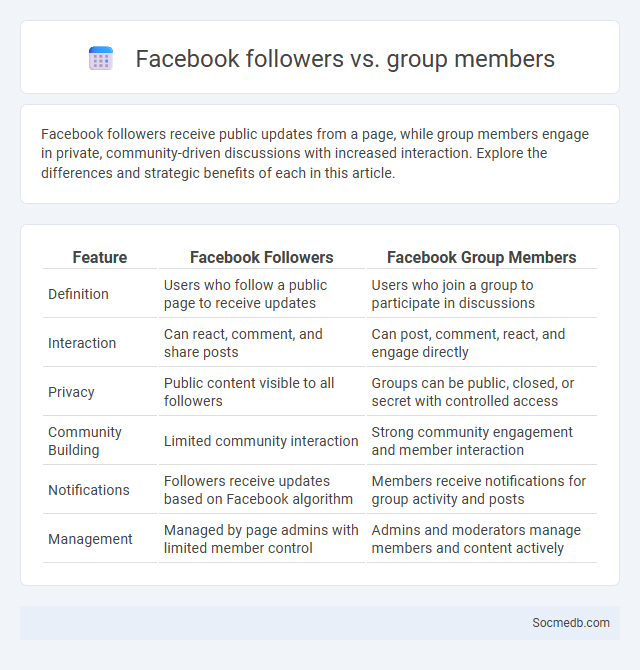
Photo illustration: Facebook Followers vs Group Members
Facebook followers receive public updates from a page, while group members engage in private, community-driven discussions with increased interaction. Explore the differences and strategic benefits of each in this article.
Table of Comparison
| Feature | Facebook Followers | Facebook Group Members |
|---|---|---|
| Definition | Users who follow a public page to receive updates | Users who join a group to participate in discussions |
| Interaction | Can react, comment, and share posts | Can post, comment, react, and engage directly |
| Privacy | Public content visible to all followers | Groups can be public, closed, or secret with controlled access |
| Community Building | Limited community interaction | Strong community engagement and member interaction |
| Notifications | Followers receive updates based on Facebook algorithm | Members receive notifications for group activity and posts |
| Management | Managed by page admins with limited member control | Admins and moderators manage members and content actively |
Understanding Facebook Followers: An Overview
Understanding Facebook followers involves analyzing their demographics, interests, and engagement patterns to tailor your content effectively. Your followers' behavior data, including likes, shares, and comments, provides valuable insights for optimizing post timing and relevance. Tracking follower growth and interaction rates helps enhance your social media strategy to boost brand awareness and audience loyalty.
What Are Facebook Group Members?
Facebook Group members are individuals who join a specific group on the platform to engage with a shared interest, community, or cause. They can participate by posting content, commenting, liking, and accessing group resources based on the group's privacy settings. The member count reflects the group's reach and activity level within the Facebook ecosystem.
Differences Between Followers and Group Members
Followers on social media are individuals who subscribe to your public updates and content, allowing you to reach a broad audience without requiring active engagement. Group members participate in a more interactive community within a defined space, enabling deeper discussions and relationship-building around shared interests. Understanding the distinction helps optimize your strategy by tailoring content for passive followers and fostering active participation among group members.
Advantages of Having Facebook Followers
Having a large number of Facebook followers enhances your brand's visibility and credibility, making it easier to reach a wider audience. Engaged followers increase your content's organic reach, driving traffic and boosting potential sales. Your social media presence strengthens customer loyalty by fostering direct interaction and real-time feedback.
Benefits of Building Facebook Groups
Building Facebook Groups enhances community engagement by fostering direct interaction and shared interests among members. Your brand visibility increases as group members actively participate, creating organic promotion and authentic connections. This platform also enables targeted communication, allowing you to address specific audience needs and gather valuable feedback for continuous improvement.
Comparing Engagement: Followers vs Group Members
Engagement on social media platforms often varies significantly between followers and group members, with group members typically showing higher interaction rates due to active participation in communities centered around specific interests. Followers may passively consume content, resulting in lower engagement metrics such as likes, comments, and shares compared to the dynamic discussions within groups. Analyzing data from platforms like Facebook and LinkedIn reveals that group members contribute more frequently to content creation and discussion, enhancing overall engagement quality and fostering brand loyalty.
Reaching Your Audience: Timeline vs Group Posts
Reaching Your Audience effectively on social media requires strategic use of both timeline and group posts. Timeline posts increase your public visibility and allow broader brand exposure, while group posts foster direct engagement with niche communities interested in your content. To maximize impact, tailor your messaging to fit the unique audience behavior on each platform, ensuring Your content resonates and drives meaningful interaction.
Growth Strategies: Followers vs Group Recruitment
Maximizing social media impact involves balancing follower growth and group recruitment for comprehensive engagement. Followers increase your brand visibility and reach across platforms like Instagram and Twitter, while group recruitment fosters a tight-knit community for deeper interaction and loyalty. You should evaluate your goals to prioritize either broad exposure or active community participation to tailor your growth strategy effectively.
Monetization Opportunities: Followers and Groups
Social media platforms offer numerous monetization opportunities through followers and groups by enabling You to leverage large, engaged audiences for sponsored content, affiliate marketing, and direct sales. Influencers and group admins can capitalize on targeted demographics to generate income via brand partnerships, exclusive membership fees, and product promotions. Maximizing group engagement increases trust and conversion rates, making communities valuable assets for sustained revenue streams.
Best Practices for Leveraging Both Followers and Groups
Maximize your social media impact by actively engaging with both followers and groups, fostering authentic interactions that build trust and loyalty. Tailor content to group interests while encouraging followers to share and comment, boosting visibility and community growth. Consistently monitor engagement metrics to refine strategies for optimal reach and relationship-building.
 socmedb.com
socmedb.com